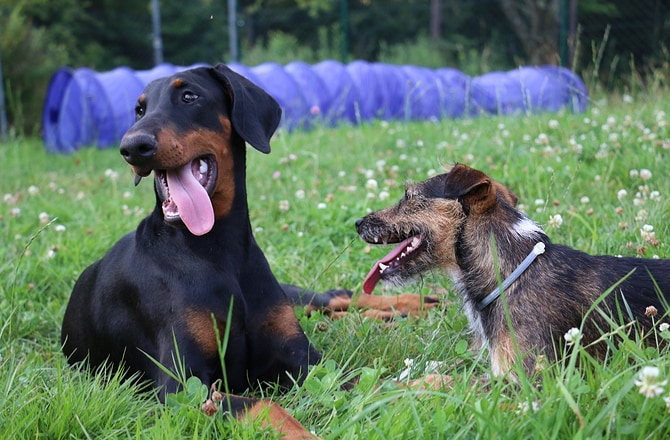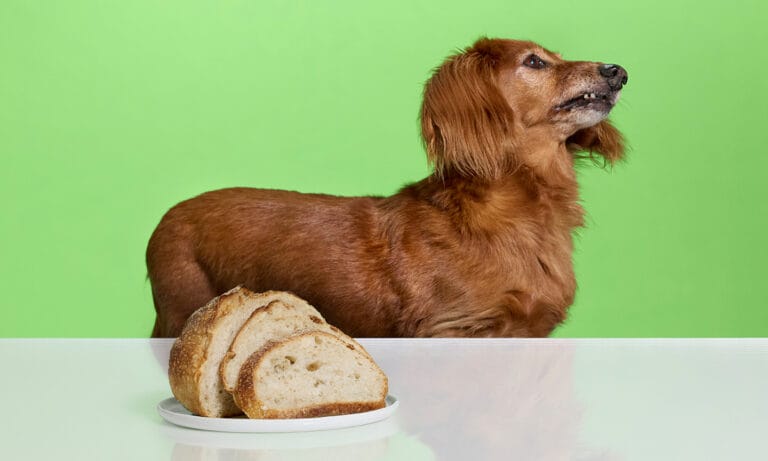Whether you’ve got a puppy in need of socialization or an adult dog that you’re dying to introduce to your best friend’s new rescue, setting up a successful play date takes some planning. Being a good canine matchmaker requires that you consider the temperaments of both players, the logistics of the meeting area and how things will unfold once the dogs are in the same space. The good news is, if you do it right, a successful get together is fun for everyone! Here’s how to make sure your next puppy play date is a purely positive party.
1. Know What Your Dog Digs
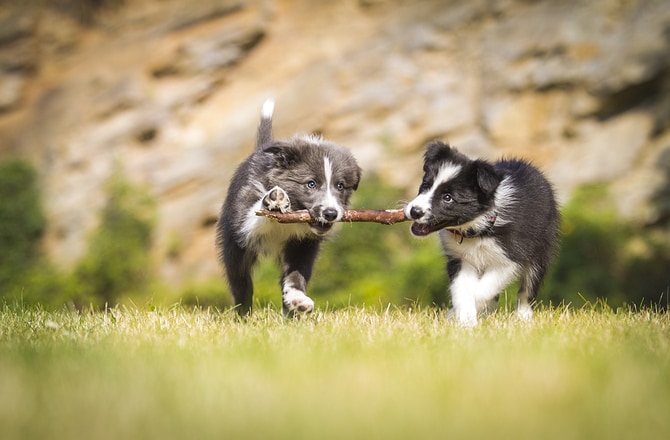
The first secret to setting up a successful play date is understanding your dog’s likes and dislikes. That means you should already know how your dog reacts to other dogs (and if it’s anything other than positive and welcoming, abandon ship), and you should have an idea as to how he likes to interact with canine companions.
If your potential play partner’s dog is a devoted wrestler and you’ve got a fleet-footed chaser, you might want to rethink the match-up. If you’re trying to socialize a new puppy, you won’t necessarily know his preferred play style yet, but the good news is you have a lot more leeway when it comes to puppy interactions. Puppy play styles are less rigidly defined as compared to adolescent and adult dog play, so it’s likely that well-socialized pups of a similar size and age will enjoy each other’s company no matter how they interact together.
2. Choose Players Wisely
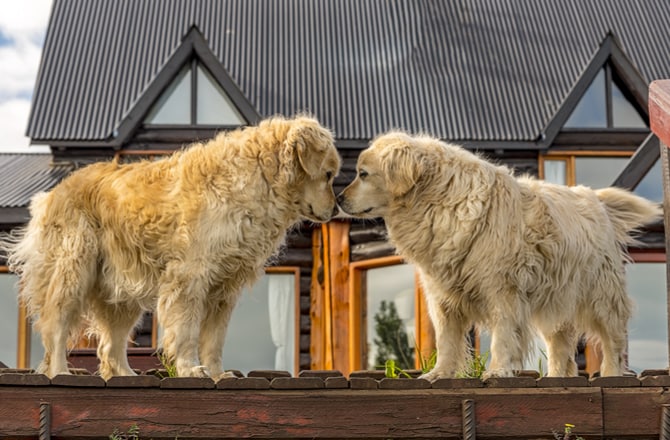
A well-matched play pal is typically close in age and size, so that one dog can’t get accidentally overwhelmed by the other’s bulk or energy level. Even if one of the players is a gentle giant, the intensity of most dog-on-dog play means there’s a greater likelihood of an accidental injury to the smaller pup. There are exceptions, of course, but the rule of thumb is to keep the pair as close to evenly matched as possible.
3. Pick a Neutral Location

This step can make scheduling an introductory play date challenging. The best play locations are safe for off-leash play (meaning, it’s a fully-fenced outdoor area or a dog-safe indoor spot), large enough to allow for the full spectrum of play styles (but not so large that the dogs are miles away from you), and don’t “belong” to either of the dogs (which prevents territory issues).
Try to find a dog-free friend with a fenced in yard or a community tennis court during the off-season, but remember to be respectful of the property and clean up any deposits.
4. Set Expectations
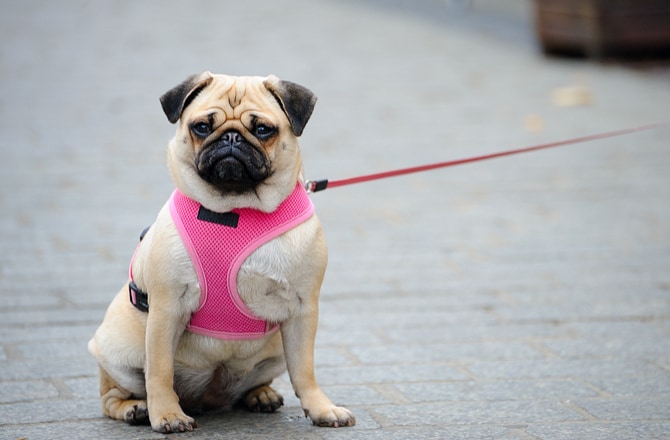
Even if you’ve done your homework about the other player and found the perfect location, there’s a chance that things might not go as planned. Sometimes dogs just aren’t that into each other, whether it’s because of differing play styles, mismatched personalities, or a missing unknowable “spark” that makes them want to romp together.
If the dogs aren’t interested in hanging out, or if they’re not playing appropriately, you might have to end the session before you want to. It’s a bummer to put so much effort into planning a play date only to have to bail immediately, but the reality is that finding a good match can take time.
5. Let the Pups Set the Pace

It’s tempting to stage manage the fun when the dogs first meet, but it’s critical that they explore the environment and interact with each other in their own time. Once the dogs have had a chance to meet following proper introduction protocols, allow them to initiate the game together without your intervention. It’s helpful to acknowledge appropriate play with praise, but try not to helicopter-parent your dog as he decodes his new buddy.
6. Focus on the Dogs

Remember, the play date is all about the dogs having fun, not catching up on gossip with the other pet parent. Dog play morphs dramatically from moment to moment, and the best way to ensure that both dogs are continuing to play appropriately is to keep an eye on them as they romp. Watching the game enables you to interrupt if it’s starting to tip from positive to snarky. Plus, you’ll probably discover some cool new facets of your dog’s personality as you watch him spar.
7. Understand Body Language
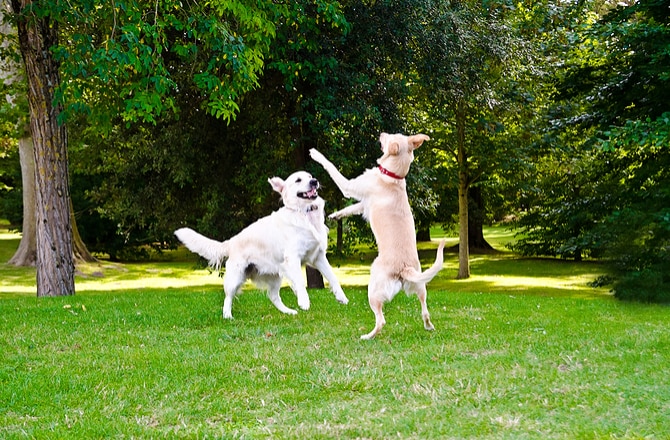
Dog play gets rowdy, and often looks and sounds scarier than it truly is. Sometimes, well-intentioned pet parents interrupt acceptable play because they’re concerned about the intensity, or ignore play that’s starting to become questionable because they don’t understand what’s actually going on. That’s why it’s so important for pet parents to recognize what the dogs are saying to each other as they interact.
Gaining an understanding of appropriate play (which is bouncy and loose) and inappropriate play (which is controlled and focused) will both keep the dogs safe. That said, it is a good idea to interrupt positive play for occasional cool downs. Sometimes the pups need to be reminded to take it down a notch and a two-minute time-out is a great way to calm the energy levels and reset the interaction.
8. Encourage Hydration Breaks

Dog play is thirsty work, so make sure to have a water supply and bowl handy. If possible, bring a bowl other than the one your dog uses every day to prevent any resource guarding, and size up in case the dogs want to sip at the same time. Drinking together can be a bonding experience in the dog world!
9. Be Toy Savvy
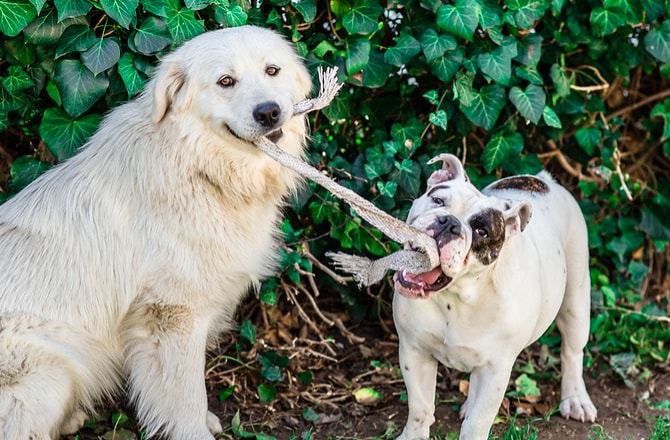
Introducing dog toys or balls can shift the focus of the play between dogs. For some dogs it adds a welcome new dimension to the game, but for others the toy can become a prize to guard. Before you toss a toy into the scrum, make sure that both dogs have a solid “drop it” cue, just in case they decide it’s too precious to share with one another. Keep-away with a toy is a fine game, but if you notice one of the dogs is going after the other when he gets too close to the toy, reclaim it to avoid escalation.

Victoria Schade is a dog trainer, author & speaker who has contributed to The Washington Post, Martha Stewart, and other publications.
Share:
